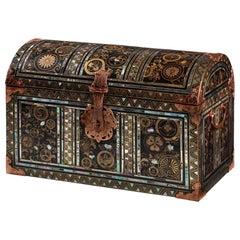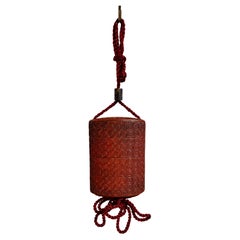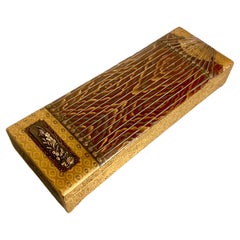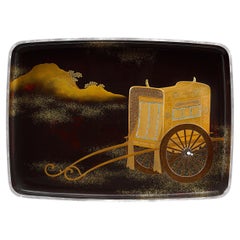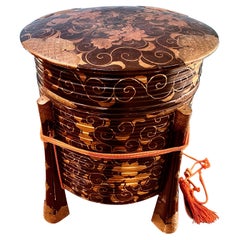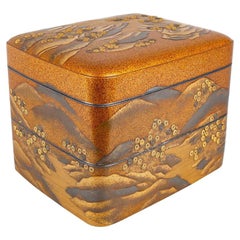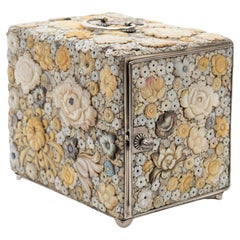Silver Lacquer
15
to
10
4
15
15
15
1
4
7
4
3
1
1
1
27,146
468
281
114
43
15
13
12
2
1
Material: Silver
A rare Japanese Namban export lacquer coffer with Mon emblems
Located in Amsterdam, NL
Late Momoyama period, late 16th century
The coffer is decorated in black lacquer, urushi, on cedar wood, decorated with gold dust and silver, maki-e, and nashiji, mother-of-pearl, r...
Category
16th Century Japanese Antique Silver Lacquer
Materials
Silver, Copper
Vietnamese Lacquer By Dinh Hanh
Located in Jersey City, NJ
Dinh Hanh is a Vietnamese painter known for his works which juxtapose a traditional technique of multi-layered lacquer on wood with modernist representations...
Category
Late 20th Century Vietnamese Silver Lacquer
Materials
Silver Leaf
Japanese Carved Cinnabar Lacquer Inro, Meiji Period, late 19th c, Japan
Located in Austin, TX
A good Japanese carved cinnabar three case inro with mixed metal ojime, Meiji period, late 19th century, Japan.
The three case inro of standard form, comprised of three container se...
Category
Late 19th Century Japanese Meiji Antique Silver Lacquer
Materials
Silver, Copper
Japanese Lacquer Writing Box, Suzuribako, Edo Period, 18th Century, Japan
Located in Austin, TX
An exceptionally fine and unusual Japanese lacquer writing implements box, suzuribako, in the form of a zither, koto, Edo Period, 18th century, Japan. With a modern wood storage box,...
Category
18th Century Japanese Edo Antique Silver Lacquer
Materials
Gold, Silver, Copper
Japanese 19th Century Miniature Lacquer Chest with Waterfall
Located in Hudson, NY
Japanese 19th century miniature lacquer chest with waterfall. Late Edo to early Meiji period lacquer chest (mid to late 19th century) with two characters on the front reading Nuno an...
Category
Late 19th Century Japanese Antique Silver Lacquer
Materials
Gold, Silver, Bronze
Japanese Lacquer Tray
Located in New Orleans, LA
Hailing from illustrious Meiji-period Japan, this lacquer tray showcases the mastery of Japanese craftsmen. Precious materials are precisely inlaid in the lacquer base, creating an a...
Category
Late 19th Century Japanese Meiji Antique Silver Lacquer
Materials
Silver
Japan 1900 Meiji Miniature Hanagamidai Cabinet in Gilded Wood & Sterling Silver
Located in Miami, FL
Miniature hanagamidai cabinet from the Japan meiji (1858-1912) period.
Gorgeous and rare miniature drawers hanagamidai (cosmetic cabinet), created in the imperial Japan during the...
Category
Early 1900s Japanese Meiji Antique Silver Lacquer
Materials
Gold, Silver, Sterling Silver
Four magnificent 17th-century Japanese export gold lacquer Liquor or Gin bottles
Located in Amsterdam, NL
A set of four extremely rare and important pictorial-style Japanese export lacquer bottles
Edo-period, circa 1650-1680
H. 15.5 x W. 6.9 x B. 7.6 cm (each)
The bottles with red cop...
Category
Mid-17th Century Japanese Edo Antique Silver Lacquer
Materials
Copper, Gold, Silver
Japanese Red and Black Lacquer Chest with Silver Maki E Design, Taisho Period
Located in Prahran, Victoria
An antique Japanese, five drawer, black lacquered small chest. It features a pine and blossom decoration in silver maki e on each drawer front, outlined in graphic red lacquer diamon...
Category
1920s Japanese Vintage Silver Lacquer
Materials
Silver
Pair of Fine Japanese Export Lacquer Cutlery Knife Boxes, 18th Century
Located in Amsterdam, NL
A pair of fine Japanese export lacquered cutlery boxes
Kyoto or Nagasaki, late 18th century
H. 33.5 x W. 24 x D. 21 cm
The bow-fronted boxes with sloping lids flat at the top are made of hinoki wood (Cypress), coated with Japanese paper and decorated in lacquer with scattered gold birds and flowers on a nashiji background. The Japanese mounts are made of copper and both boxes still have internal partitions to keep the cutlery upright.
The form of these boxes is similar to a pictorial-style knife box in the collection of the Groninger Museum (inv. 1989- 347), dated between 1730 and 1780, but the style of the decoration is more like that on a knife box in the Peabody Essex Museum in Salem (inv. E62271), which was brought to Salem by James Devereux, Captain of the Franklin, in 1799.
Provenance:
Henriette Jeane Christine van Neukirchen, called Nyvenheim (1807- 1849) and Nicolaas Johan Steengracht van Oostcapelle (1806-1866), thence by descent to the last owners, Ludolphine Emilie baronesse Schimmelpenninck van der Oye (1944) married in 1969 to Roland Daniel van Haersma Buma (1944), the last residents of castle Duivenvoorden near Voorschoten and the great-great-granddaughter of Nicolaas Johan Steengracht van Oostcapelle.
There is no evidence that Nicolaas Johan himself, or any of his or his wife’s ancestors had ever been in Japan. However, Nicolaas’ grandfather (Nicolaas Steengracht, 1754-1840) was a director of both the VOC and WIC (West Indies Company...
Category
Late 18th Century Japanese Antique Silver Lacquer
Materials
Silver
Rare Antique Qing Dynasty Chinese Gilt Silver Filigree And Enamel Brise Fan
Located in Brea, CA
Rare Fine Antique early 19th century Chinese gilt silver filigree and enamel brise fan , Qing dynasty, the fan has 22 sticks with a 18k gold ring loop , wond...
Category
Early 19th Century Chinese Qing Antique Silver Lacquer
Materials
Silver, Enamel
20th Century Japanese Meiji Period Silver & Gold Lacquer Smoking Set, circa 1900
Located in Royal Tunbridge Wells, Kent
Antique early 20th century Japanese Meiji period very fine gold lacquer and silver smoking set (tabako-bon), boat shaped with a removable draw, lacquer is decorated with ocean waves ...
Category
Early 20th Century Japanese Silver Lacquer
Materials
Silver
Japanese Lacquer Koro 'Incense Burner'
Located in Hudson, NY
Removable bronze top, with gold drip pattern at top. Cresting ocean waves on bottom with raised silver sea spray.
Category
Early 19th Century Japanese Edo Antique Silver Lacquer
Materials
Silver, Bronze
Burmese Kammavaca Giltwood Box, Stand, and Manuscript, 18th/19th Century
Located in Austin, TX
A gorgeous Burmese carved and gold leafed teakwood stand and cover for a kammavaca manuscript, late 18th or early 19th century, Burma.
The manuscript chest is heavily rococo influenced, speaking to the French presence in the region at the time. The carved teak stand is formed as a raised platform set upon four large scrolling acanthus leaf feet, with carved flour-de-lis to the apron.
The cover for the stand is also carved from teak, and features a series of rectangular cartouches, each set with a red foil backed glass "gem", surrounded by shell inlay, and embellished with green and silver foil backed glass sequins.
The top of the cover features the same design motif, with the addition of thayo lacquer design elements, and is strongly reminiscent of Tibetan manuscript...
Category
Early 19th Century Burmese Rococo Antique Silver Lacquer
Materials
Gold Leaf, Foil, Silver Leaf
Spectacular Incense Box, Hills and River, Gold and Silver Chrysanthemums
Located in Hudson, NY
Incense box in nashiji lacquer with design of river flowing through highly defined hills that are strewn with chrysanthemums. Several uses of gold lacquer, cut gold and gold sheeting, along with silver, create a dramatic design of exemplary 19th century work. The tiered box...
Category
Late 19th Century Japanese Antique Silver Lacquer
Materials
Gold, Silver
Related Items
Japanese Lacquer Hokai Box, 19th Century
Located in Pasadena, CA
This is a good example of a traditional Japanese Hokai shell storage box for the Kai-awase game. This box is well-detailed in chased brass appliques and makie. The box is in overall ...
Category
Late 19th Century Japanese Japonisme Antique Silver Lacquer
Materials
Wood, Lacquer
Lacquer Table, Late Meiji Period, Japan, circa 1900
Located in Buenos Aires, Buenos Aires
Lacquer table, Art Deco period, Japan, circa 1900.
Category
Early 1900s Japanese Art Deco Antique Silver Lacquer
Materials
Lacquer
Pair of Antique Japanese Lacquer Trays
Located in Hudson, NY
Pair of antique Japanese Lacquer Trays, Taisho period (1912-1926) beautifully decorated with a miniature landscape of pea pods on the vine and a gold cricket set...
Category
1920s Japanese Taisho Vintage Silver Lacquer
Materials
Lacquer
Signed Mid 19th C. Edo/Meiji Period Miniature Lacquer Stacking Cabinet, Japan
Located in Oxfordshire, United Kingdom
The highly decorated tray in the form of a table frames a series of three stacking boxes, a further three lidded boxes and a tray concealed within, raised on ogee bracket feet.
This...
Category
19th Century Japanese Meiji Antique Silver Lacquer
Materials
Lacquer
Free Shipping
H 4.89 in W 5.12 in D 3.51 in
Japanese Lacquer Box
Located in New York, NY
A Japanese red burgundy, gold and black lacquer box with round corners and silk cloth interior lining, circa early-20th century, 1920s, Japan. Box was desi...
Category
Early 20th Century Japanese Silver Lacquer
Materials
Wood, Silk
Japanese Lacquer and Cinnabar "Samurai" Cabinet, Inaba Family, Edo Period
Located in Troy, NY
Exceptionally large and rare lacquer cabinet. According to the heraldry, visible on the headgear in one of the panels, it was made for the Inaba family, a high ranking Daimyo family,...
Category
Late 19th Century Japanese Edo Antique Silver Lacquer
Materials
Wood
Japanese Lacquer Incense Burner, Koro, Edo period, mid 19th century, Japan
Located in Austin, TX
An elegant and refined Japanese lacquer koro, incense burner, in the form of a chaire, tea caddy, Edo Perio, mid 19th century, Japan.
The barrel shaped koro formed as a traditional ...
Category
Mid-19th Century Japanese Edo Antique Silver Lacquer
Materials
Copper
Pair of Edo Period Black and Gold Lacquer Samurai Helmet Boxes
Located in Lymington, Hampshire
A pair of Edo period black and gold lacquer Samurai helmet boxes (Hakko Bako), each of ribbed cylindrical form with a lid, a black lacquer interior,...
Category
19th Century Japanese Edo Antique Silver Lacquer
Materials
Lacquer
Japanese Maki-e Lacquer Document Box, Edo Period, early 19th Century, Japan
Located in Austin, TX
A spectacular Japanese maki-e lacquer lidded box, possibly a writing box, suzuribako, decorated with images of folding fans, ogi, Edo Period, earl...
Category
Early 19th Century Japanese Edo Antique Silver Lacquer
Materials
Coral
Japan Red Lacquered Box 19th century
Located in Beuzevillette, FR
Beautiful Japanese box in red lacquered wood;
19th century
The lid is decorated with a landscape with a bird, trees and a setting sun.
The inside of the box is covered with a lacque...
Category
Late 20th Century Silver Lacquer
Materials
Wood
Japanese Inro with Netsuke, Late 19th C
Located in Stockholm, SE
A high quality lacquer inro with a carved wooden netsuke. Both are unfortunately damaged but still very nice art pieces. The way the rooster is executed is just exquisite.
Category
Late 19th Century Japanese Antique Silver Lacquer
Materials
Boxwood, Lacquer
Japanese Lacquer Stationery Box, Suzuribako, Edo Period, 19th c, Japan
Located in Austin, TX
A fine and elegant Japanese lacquer box for writing implements or stationery, suzuribako, with an image of a Shinto shrine, Edo Period, mid-19th century, circa 1840, Japan.
The exqu...
Category
Mid-19th Century Japanese Edo Antique Silver Lacquer
Materials
Gold Leaf
Free Shipping
H 1.75 in W 6.25 in D 9 in
Previously Available Items
Spectacular Incense Box, Hills and River, Gold and Silver Chrysanthemums
Located in Hudson, NY
Incense box in nashiji lacquer with design of river flowing through highly defined hills that are strewn with chrysanthemums. Several uses of gold lacquer, cut gold and gold sheeting, along with silver, create a dramatic design of exemplary 19th century work. The tiered box...
Category
Late 19th Century Japanese Antique Silver Lacquer
Materials
Gold, Silver
Japan shibayama flowers incense cabinet kodansu
Located in PARIS, FR
Exceptional Japanese incense cabinet kodansu in wood covered with a profusion of mother-of-pearl flowers and bone leaves, engraved and inlaid with the shibayama technique. Bottom in ...
Category
Early 20th Century Japanese Japonisme Silver Lacquer
Materials
Silver
Japan 1810 Edo Period Takamaki-e Five Drawer Inro In Lacquered Wood With A Hawk
Located in Miami, FL
Japanese Inro with a Hawk from the Edo Period (1603-1867).
Beautiful Inro, created in Japan during the Edo period (Shogunate), circa 1810. It was carefully crafted in carved preciou...
Category
1810s Japanese Edo Antique Silver Lacquer
Materials
Coral, Silver
H 3.5 in W 1.62 in D 1.5 in
Japan 1830 Edo Period Six Drawer Inro In Lacquered Gilt Wood With A Carriage
Located in Miami, FL
Japanese Inro from the Edo Period (1603-1867).
Beautiful Inro, created in Japan during the Edo period (Shogunate), circa 1830. It was carefully crafted in carved precious wood with applications of lacquer and decorated with orientalism patterns. All dan trays are attached together with a himo cord. The detailed craftsmanship was a true pleasure to behold.
Period: Edo 1606-1867, Shogunate.
Approximate Date: 1830
Motif: An elaborated three-dimensional royal carriage with a silvered bull and a richly dressed court companion. All surrounded by a road and sinuous mountainous landscape with trees and plants.
Drawers: Six.
Shape: Oval
Technique: Carved wood, Lacquer, hiramaki-e, takamaki-e, Gilding, Silvered.
Ojime: 15mm, round sphere carved from natural translucent carnelian
Netsuke: Patinated carved seated child playing a shakuhachi (flute) in a resting bull, signed.
Weight: 67.60 Grams.
Measurements: Inro is 92 mm by 27 mm by 38 mm (3.60 x 1.06 x 1.50 Inches).
The Edo Period
The Edo period or Tokugawa period is the period between 1603 and 1867 in the history of Japan, when Japan was under the rule of the Tokugawa shogunate and the country's 300 regional daimyo. Emerging from the chaos of the Sengoku period, the Edo period was characterized by economic growth, strict social order, isolationist foreign policies, a stable population, perpetual peace, and popular enjoyment of arts and culture. The period derives its name from Edo (now Tokyo), where on March 24, 1603, the shogunate was officially established by Tokugawa Ieyasu. The period came to an end with the Meiji Restoration and the Boshin War, which restored imperial rule to Japan. The Tokugawa (or Edo) period brought 250 years of stability to Japan. The political system evolved into what historians call bakuhan, a combination of the terms bakufu and han (domains) to describe the government and society of the period.[3] In the bakuhan, the shōgun had national authority and the daimyo had regional authority. This represented a new unity in the feudal structure, which featured an increasingly large bureaucracy to administer the mixture of centralized and decentralized authorities. The Tokugawa became more powerful during their first century of rule: land redistribution gave them nearly seven million koku, control of the most important cities, and a land assessment system reaping great revenue
Inro
Is a traditional Japanese case for holding small objects, suspended from the obi (sash) worn around the waist when wearing a kimono. They are often highly decorated with various materials such as lacquer and various techniques such as maki-e, and are more decorative than other Japanese lacquerware. Because traditional Japanese dress...
Category
1830s Japanese Edo Antique Silver Lacquer
Materials
Gold, Silver
H 3.6 in W 1.5 in D 1.06 in
Japanese lacquer suzuri’bako 箱 with a cherry blossom & Chinese landscape design
Located in Amsterdam, NL
A very well-made, beautiful black lacquer rectangular suzuri’bako (writing box) with rounded corners. The well-fitted overhanging cover with a design of a ...
Category
19th Century Japanese Antique Silver Lacquer
Materials
Silver
Free Shipping
H 1.89 in W 9.38 in D 10.2 in
Antique Japanese Lacquer Kobako with Silver Inlays Edo Period
Located in Atlanta, GA
A small but intricately decorated Japanese lacquer box Kobako from Edo period circa 18th century with possible lineage traced to Kishu Tokugawa family. The box was likely used to con...
Category
18th Century Japanese Japonisme Antique Silver Lacquer
Materials
Silver
Antique Japanese Black Lacquer Noh Mask Box with Gold Maki e Design, Edo Period
Located in Prahran, Victoria
A Japanese Noh mask box, in black lacquer with a gold and silver maki e Rimpa style landscape design featuring a bird sitting in maple trees with mou...
Category
19th Century Japanese Antique Silver Lacquer
Materials
Bronze, Gold, Silver
H 9.85 in W 11.82 in D 9.45 in
Nashiji and Fundame Gold Lacquer Flute Box
Located in Hudson, NY
Features design of moon-lit landscape with waterfall over craggy rocks. Moon is sheet silver, lacquer work is gold, cut sheet gold and varying lacquer techniques. Cord is attached to...
Category
Early 18th Century Japanese Edo Antique Silver Lacquer
Materials
Gold, Silver
Exceptional Japanese Lacquer Suzuribako Edo Period with Provenance Note
Located in Atlanta, GA
An exceptional Japanese suzuribako (writing box) in maki-e decoration circa 18th century Edo period. This is one of the most spectacular pieces of ...
Category
18th Century Japanese Japonisme Antique Silver Lacquer
Materials
Stone, Silver
Exquisite Early Japanese Lacquer Kobako Box with Insert Tray
Located in Atlanta, GA
An early Japanese lacquer kobako (small box) in octagon shape circa 16th-17th century (late Muromachi to Momoyama period). This kobako was possibly used as...
Category
17th Century Japanese Japonisme Antique Silver Lacquer
Materials
Silver
Meiji Period Japanese Lacquer Placque with Autumn River Scene
Located in Hudson, NY
Meiji Period Japanese lacquer Placque with Autumn River Scene. Early Meiji period (1868 -1912) lacquer plaque with original bronze mounts and wonderful lacquer details depicting mapl...
Category
Late 19th Century Japanese Meiji Antique Silver Lacquer
Materials
Gold, Silver
Fine Japanese Set of Lacquer Maki-E Box and Tray Meiji Period
Located in Atlanta, GA
The set consists of a hand box (tebako) with silver metal trim and a matching under tray in black lacquer background with fine maki-e decoration. The motifs on the surface was created using low relief maki-e (hiramakie) in combination with gold fundame, depicting an arrangement of seasonal plants traditionally associated with autumn in Japanese culture. On the cover of the tebako, a Japanese clematis flower takes the center stage. On the lower part demarcated with a silvery semi-sphere, Patrinia (golden laces, Ominaeshi in Japanese) sways in the wind. On the side of the box, there grows a cluster of Chinese bell...
Category
19th Century Javanese Japonisme Antique Silver Lacquer
Materials
Silver
Recently Viewed
View AllMore Ways To Browse
Maki E
Antique Japanese Lacquer Tray
Japanese Lacquer Tray Antique
Antique Chinese Cinnabar
Black Lacquer Asian Floral
Vintage Japanese Lacquer
Red Lacquer Cinnabar
Lacquer Ware
Asian Small Lacquer Box
Japanese Family Crest
Japanese Black Lacquer Tray
Black Cinnabar
Kyoto Lacquer
Japanese Mother Of Pearl Art
Chinese Carved Cinnabar
Burmese Red Lacquered
Japanese Pearl Inlay
Large Japanese Tray
